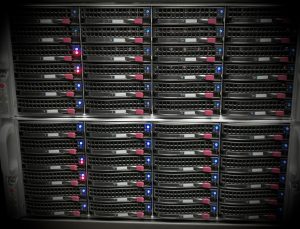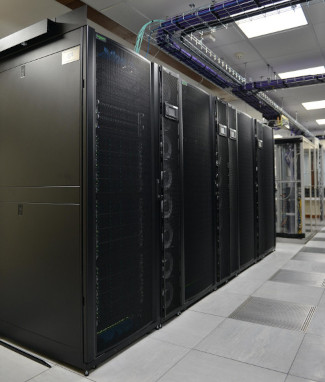Difference between revisions of "Quickstart/What Is Viper"
m |
|||
| (7 intermediate revisions by the same user not shown) | |||
| Line 1: | Line 1: | ||
==What is Viper?== | ==What is Viper?== | ||
| − | |||
Viper is the University of Hull's supercomputer and is located on-site with its own dedicated team to administrate it and develop applications upon it. | Viper is the University of Hull's supercomputer and is located on-site with its own dedicated team to administrate it and develop applications upon it. | ||
==What is a supercomputer?== | ==What is a supercomputer?== | ||
| − | + | [[ File:Vipero1cropped.jpg|frame|These 4 racks contain 180x compute nodes, 4x high memory nodes, and 5x accelerator nodes which form part of Viper.]][[ File:Storage01cropped.jpg|frame|These racks contain the storage which is 0.5 Petabyte and the controller nodes, two login nodes, and two visualisation nodes.]] | |
| + | Supercomputers are computers with a high level of computing performance compared to general-purpose computers. A supercomputer like Viper has a lot of elements of a desktop computer — processors, memory, disk, operating system — just more of them. | ||
==Why do we need a supercomputer?== | ==Why do we need a supercomputer?== | ||
| Line 14: | Line 14: | ||
High-performance computers achieve a high level of performance by allowing the user to split a large job into smaller computation tasks which then run in parallel, or by running a single task with many different scenarios on the data across parallel processing units. | High-performance computers achieve a high level of performance by allowing the user to split a large job into smaller computation tasks which then run in parallel, or by running a single task with many different scenarios on the data across parallel processing units. | ||
| − | + | Similar to all other supercomputers Viper runs on [http://linux.co.uk Linux], which is similar to UNIX in many ways and has a wide body of software to support it. | |
==Who can use Viper?== | ==Who can use Viper?== | ||
| − | Viper is available to all research staff and postgraduates at the University of Hull for free | + | Viper is available to all research staff and postgraduates at the University of Hull for free and provides an environment that will stimulate innovation and support world-class [https://hpc.wordpress.hull.ac.uk/research-outputs/ research]. |
Viper is currently used for: | Viper is currently used for: | ||
| Line 30: | Line 30: | ||
* And many more | * And many more | ||
| − | == | + | == Viper's hardware == |
{| class="wikitable mw-collapsible " | {| class="wikitable mw-collapsible " | ||
| Line 43: | Line 43: | ||
|- | |- | ||
|[[File:Acceleratornodes.jpg]] | |[[File:Acceleratornodes.jpg]] | ||
| − | |'''Accelerator Nodes'''<br>Also known as GPU nodes. We have | + | |'''Accelerator Nodes'''<br>Also known as GPU nodes. We have 5 GPU nodes, each identical to compute nodes with the addition of an Nvidia Ampere A40 GPU per node. These are almost similar to high-end graphics cards found in gaming rigs. The usefulness of these cards is that they have thousands of very small processing cores in them and this makes them very useful for executing small amounts of code but in a massively parallel way. This is why these cards are used in the areas of machine learning and deep learning. |
|- | |- | ||
|[[File: Visualisationnodes.jpg]] | |[[File: Visualisationnodes.jpg]] | ||
| Line 52: | Line 52: | ||
|- | |- | ||
|[[File: Storagenodes.jpg]] | |[[File: Storagenodes.jpg]] | ||
| − | |'''Storage Nodes'''<br>These are servers in their own right which allow access to the actual storage arrays (hard disks), Viper accesses | + | |'''Storage Nodes'''<br>These are servers in their own right which allow access to the actual storage arrays (hard disks), Viper accesses its disk storage via these nodes. |
|- | |- | ||
|[[File: Storagearray.jpg]] | |[[File: Storagearray.jpg]] | ||
| Line 70: | Line 70: | ||
| − | [[ | + | [[Main Page #Quickstart| Back]] / [https://viper.hull.ac.uk/ Next (Apply for an account)] |
Latest revision as of 10:00, 9 December 2022
Contents
[hide]What is Viper?
Viper is the University of Hull's supercomputer and is located on-site with its own dedicated team to administrate it and develop applications upon it.
What is a supercomputer?
Supercomputers are computers with a high level of computing performance compared to general-purpose computers. A supercomputer like Viper has a lot of elements of a desktop computer — processors, memory, disk, operating system — just more of them.
Why do we need a supercomputer?
The point of having a high-performance computer is so that the individual nodes can work together to solve a problem larger than any one computer can easily solve.
Supercomputers generally aim for the maximum in capability computing rather than capacity computing. Capability computing is typically thought of as using the maximum computing power to solve a single large problem in the shortest amount of time. Often a capability system is able to solve a problem of a size or complexity that no other computer can, e.g., a very complex weather simulation application.
How does Viper work?
High-performance computers achieve a high level of performance by allowing the user to split a large job into smaller computation tasks which then run in parallel, or by running a single task with many different scenarios on the data across parallel processing units.
Similar to all other supercomputers Viper runs on Linux, which is similar to UNIX in many ways and has a wide body of software to support it.
Who can use Viper?
Viper is available to all research staff and postgraduates at the University of Hull for free and provides an environment that will stimulate innovation and support world-class research.
Viper is currently used for:
- Astrophysics
- BioEngineering
- Business School
- Chemistry
- Computer Science
- Computation Linguistics
- Geography
- And many more
Viper's hardware
| Hardware | [Collapse] |

|
Compute Nodes These make up most of the computing nodes and perform most of the standard computing processes within the HPC. Each node has 128GByte of RAM. |

|
High Memory Nodes These are very similar to the compute nodes but they have much more memory, ours have a 1 Tera Byte of RAM each which makes them ideal for research involving large memory models like engineering and DNA analysis in biology. |

|
Accelerator Nodes Also known as GPU nodes. We have 5 GPU nodes, each identical to compute nodes with the addition of an Nvidia Ampere A40 GPU per node. These are almost similar to high-end graphics cards found in gaming rigs. The usefulness of these cards is that they have thousands of very small processing cores in them and this makes them very useful for executing small amounts of code but in a massively parallel way. This is why these cards are used in the areas of machine learning and deep learning. |

|
Visualisation Nodes These are used for connecting from remote computers such as desktops and allow the rendered outputs from data to be viewed on a local computer. There are two visualisations nodes with 2x Nvidia GTX 980TI. |

|
High Speed Network All these compute nodes are connected by a very fast Intel Omni-path network to allow the compute nodes to act together. This runs at 100Gbit/s. |

|
Storage Nodes These are servers in their own right which allow access to the actual storage arrays (hard disks), Viper accesses its disk storage via these nodes. |

|
Storage Array These are the actual disks held in a chassis and make up the whole file storage for Viper. Viper has a total file space of 0.5 Petabyte or 500 Terabyte. |

|
Controller Node The controller nodes are responsible for the management of all the compute nodes. Managing the loading of jobs, their termination and completion via the job scheduler, for Viper this is SLURM. |

|
Login Nodes These are the nodes which allow the user to log in to the cluster, this area is then used by the user to prepare jobs for the cluster. Although this is a server in its own right it is not used for computing work. |


